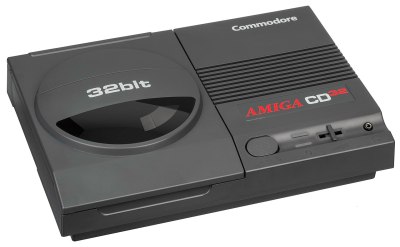
My first love was a black wedge. It was 1982, and I had saved up to buy a Sinclair ZX81. That little computer remains the only one of the huge number that I have owned over the years about which I can truly say that I understood its workings completely; while I know how the i7 laptop on which this is being written works I can only say so in a loose way as it is an immensely complex device.
Computing allegiance is fickle, and while I never lost an affection for the little Sinclair I would meet my true electronic soulmate around eight years later as an electronic engineering student. It no longer graces my bench, but this was the computer against which all subsequent machines I have owned would be measured, the one which I wish had not been taken from me before its time, and with which I wish I could have grown old together. That machine was a Commodore Amiga, and this is part love letter, part wistful musing about what could have been, and part rant about what went wrong for the best desktop computer platform ever made.
Just Why Was The Amiga So Good?
If we had been so convinced by the promise of the Amiga platform to the extent of not seeing the shaky foundations upon which it had been built, just what was it that had seduced us? Perhaps at this point it’s worth taking a quick look at the competition in the world of 16-bit or above computers, to see what else we could have had in our dorm rooms. This is a view from the UK so your market may have had some other players, but for us there were probably five main contenders. If you didn’t have an Amiga you might have had an Atari ST, if your parents chose the computer for you then you had an Amstrad PC-XT clone, if your school had used them you could have had an Acorn Archimedes, and if your parents were very rich you might have had an all-in-one Mac. The Apple IIgs wasn’t big for Brits, and though the Texas Instruments home computers were 16-bit they had been competitors for the 8-bit era.

Of the other platforms, the Atari had MIDI but the TOS/GEM operating system and desktop was clunky, the PC was what everyone told you was the thing to have but was slow with no sound and awful graphics, the Archimedes was cool and very quick indeed but a bit weird, and the Mac was awesome but unaffordable. The Amiga by comparison was affordable, had amazing graphics for the day, had good audio, had a slick GUI over a proper multitasking OS, and felt fast due to its custom coprocessor chips. By my final year as a student, people were buying 386sx-25 PCs with Windows 3.1, and even those supposed powerhouses felt sluggish and cumbersome compared to the Amiga.
There was of course nothing special about a 68000 running at 7.16 MHz, the key was in the Amiga’s ROM-based OS and those extra-special custom chips that meant that the 68k could compute rather than waste its time on graphics and waiting more than necessary for disk drives. Mine got me through an electronic engineering undergraduate course: it compiled C programs, edited audio for student radio, played marathon overnight Lemmings sessions, and even once spent more than a day rendering the obligatory ray traced mirror ball over a checkerboard surface.
We Made Amiga. They F****d It Up
The above phrase was a legend back in 1990 when I had my first A500, a message buried in the version 1.2 Kickstart ROM. It was a commentary from surviving members of the Amiga development team on Commodore’s dismal management and marketing, but we tech-obsessed youths drinking the Amiga Kool-Aid a a few years later were naive and ignorant of such matters. For us it was streets ahead of everything else and was sure to have a promising future. How wrong we were.

A very illuminating read as a former Amiga user came from our Hackaday colleague Bil Herd, in Back into the storm, his autobiographical account of working for Commodore in the mid-1980s. He was bringing us the TED series of 8-bit computers rather than the Amiga, but he illustrates well the chaos and ineptitude reigning in the upper levels.
The impression I gained from it and reading about the early history of the Amiga was that the engineering teams were building impressive hardware, but the company was hell bent on hammering everything to be another Commodore 64 rather than recognising that the computer market had potential beyond a mass-market home gaming platform. It’s a story repeated through the later years of the Amiga by [Dave Haynie], who gives us tantalising glimpses of the Amigas we might have had, when what we were given in the early 1990s was underwhelming and far too little too late.
The infamous phrase from the 1.2 Kickstart ROM referred to Commodore’s dismal marketing for the original Amiga 1000 in 1985 when it could have stood alongside the best of its competition or ahead of many. Commodore’s founder Jack Tramiel had alienated his dealership network before his departure, and a scarcity of supply alongside the most underwhelming of TV advert campaigns was not destined to make up any shortfall. The dismal marketing continued with the much more affordable Amiga 500 and its A2000 professional stablemate. The A500 became a hit despite, rather than because of, Commodore’s efforts.
From Infinite Promise To A Failed Game Console

While their would-be competitor Apple upgraded their lines with new models containing faster processors and more expansion, Commodore rested on their laurels. Over the seven years following the launch of the A1000 they would repackage essentially the same 7.16 MHz 68000 multiple times in a pretence of releasing new models , culminating in 1992 as the writing was on the wall, with the Amiga 600.
When they did upgrade to a 68030 with the A3000 it was in a top-end model out of reach of most customers, and when a 68020 made its way into a low-end Amiga in the A1200 it was the penny-pinching “EC” version without a memory management unit.
By the time Commodore finally went bust in 1994 after a failed attempt to take on Sega and Nintendo with what was essentially an A1200 in a console, the Amiga line was seen as primarily a gaming platform, and an increasingly outdated one at that. Ownership passed through Escom and then Gateway with no new models, and eventually ended up with the name licensed, now a minority platform for a few enthusiasts. The flame is still just about alight as the occasional OS update proves, but the dream is definitely over.
It’s easy to fall into wistful might-have-been stories, as no doubt happens whenever a few Amiga enthusiasts raise a glass. None of us were in the Commodore boss’s office, even though it’s hard to believe we could have done a worse job. It’s not difficult to see what they might have tried: meaningful hardware upgrades and a move to standard interfaces such as PCI among them. Who knows, if that had happened I might now be doing this in front of Workbench, instead of GNOME.
0 Commentaires